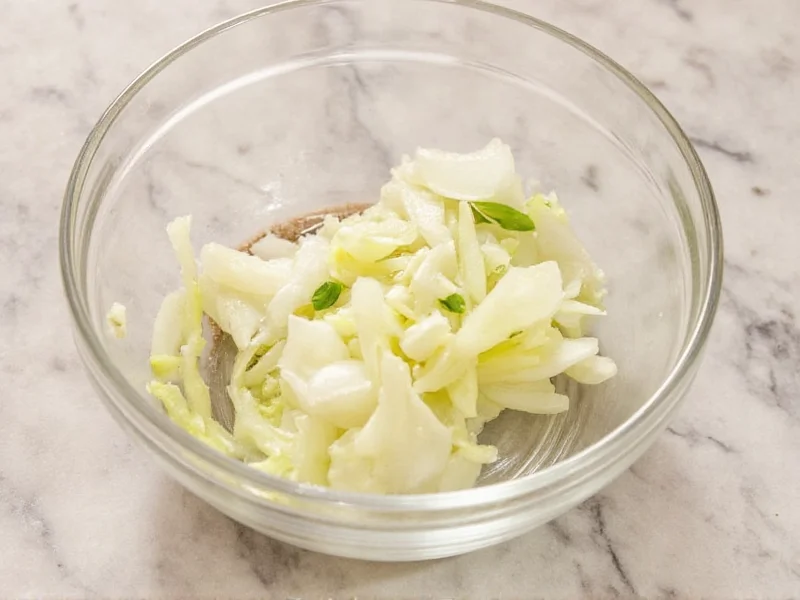1/2 teaspoon of onion powder equals approximately 2 tablespoons (30ml) of freshly minced onion. This conversion maintains equivalent flavor intensity in recipes when substituting between dried and fresh forms.
Understanding Onion Powder to Fresh Onion Conversion
When following recipes, you'll often encounter measurements requiring onion powder when you only have fresh onions available, or vice versa. Understanding the proper conversion ratio ensures your dishes maintain the intended flavor profile without becoming overpowering or bland.
The Science Behind Onion Conversions
Dehydrated onion products like powder concentrate the flavor by removing moisture. During the drying process, onions lose approximately 90% of their water content, which significantly intensifies their flavor compounds. This concentration explains why you need substantially less onion powder compared to fresh onion to achieve similar taste results.
Professional chefs and food scientists have established standardized conversion ratios through extensive recipe testing. The universally accepted ratio provides reliable results across most culinary applications:
| Onion Powder | Fresh Onion Equivalent | Visual Reference |
|---|---|---|
| 1/4 teaspoon | 1 tablespoon | 1 small cube (1/2" x 1/2" x 1/2") |
| 1/2 teaspoon | 2 tablespoons | 1 large cube (3/4" x 3/4" x 3/4") |
| 1 teaspoon | 1/4 cup | 2-3 small cubes |
| 1 tablespoon | 3/4 cup | Half a small onion |
Practical Substitution Guidelines
When converting between onion powder and fresh onions in your recipes, consider these practical factors that affect successful substitution:
Moisture Content Matters
Fresh onions introduce additional liquid to recipes that onion powder doesn't provide. When substituting fresh for powder in baked goods or thick sauces, reduce other liquids by 1-2 teaspoons per substitution to maintain proper consistency. This adjustment prevents your dishes from becoming too watery.
Flavor Development Differences
Onion powder delivers immediate flavor throughout your dish, while fresh onions require cooking time to mellow and distribute their flavor. When using fresh onions as a substitute, sauté them for 2-3 minutes before adding other ingredients to develop their sweetness and integrate flavors properly.
Recipe-Specific Considerations
Certain dishes respond better to specific onion forms:
- Dry rubs and spice blends: Onion powder works best as fresh onion would make the mixture clump
- Slow-cooked dishes: Fresh onions develop more complex flavors during long cooking times
- Finishing touches: Fresh onions provide brighter flavor in garnishes and fresh salsas
- Binding applications: Onion powder won't affect texture in meatloaf or burgers like fresh onions might
Common Conversion Mistakes to Avoid
Many home cooks make these errors when substituting between onion forms:
- Using volume measurements interchangeably: Never substitute 1/2 teaspoon onion powder with 1/2 teaspoon fresh onion - this creates an extremely weak flavor
- Ignoring recipe chemistry: In baking or precise candy making, substitutions can affect chemical reactions
- Not adjusting for onion variety: Sweet onions require slightly larger quantities than yellow onions for equivalent flavor
- Overcompensating: Doubling the fresh onion amount when substituting often creates overpowering results
When Precision Matters Most
While the standard conversion works for most everyday cooking, certain applications demand extra attention to onion measurements:
- Preserving and pickling: Acid balance depends on precise vegetable-to-liquid ratios
- Commercial food production: Consistent flavor profiles require exact measurements
- Dietary restrictions: Low-FODMAP diets require careful onion measurement
- Delicate sauces: Hollandaise or béchamel can break with excess moisture from fresh onions
Professional Chef Tips for Perfect Onion Substitutions
Seasoned culinary professionals recommend these techniques when working with onion conversions:
- For the most accurate fresh onion measurement, finely mince your onion and lightly pack it into the measuring spoon
- When substituting fresh for powder in dry mixes, add the fresh onion to other wet ingredients first to distribute evenly
- For soups and stews, add fresh onion early in cooking; for finishing flavors, add toward the end
- Store unused fresh minced onion in an airtight container with a paper towel to absorb excess moisture
Understanding Onion Varieties in Conversions
Different onion varieties affect conversion ratios slightly:
- Yellow onions: Standard conversion applies (1/2 tsp powder = 2 tbsp fresh)
- Sweet onions (Vidalia, Walla Walla): Use 25% more fresh onion for equivalent flavor
- Red onions: Slightly milder; use same conversion ratio but expect color transfer
- Shallots: More intense flavor; use 25% less fresh shallot than regular onion
Final Conversion Thoughts
Mastering the conversion between 1/2 teaspoon onion powder to fresh onion measurements empowers you to adapt recipes confidently. Remember that cooking remains an art alongside science—taste as you go and adjust according to your personal preference and the specific requirements of your dish. The standard conversion provides an excellent starting point that works reliably in most culinary situations, whether you're preparing family meals or experimenting with new recipes.
Understanding these measurement relationships between dried and fresh onion forms represents just one aspect of ingredient knowledge that transforms ordinary cooking into consistently delicious results. As you become more familiar with these conversions, you'll develop intuition for adjusting other dried-to-fresh ingredient substitutions throughout your culinary journey.











 浙公网安备
33010002000092号
浙公网安备
33010002000092号 浙B2-20120091-4
浙B2-20120091-4